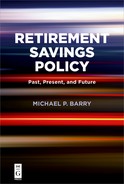Chapter 13
The Rise of the 401(k)
The charts with which we began Part I tell the story of a shift from defined benefit to defined contribution plans as “the way American workers save for retirement.” That shift can largely be explained by the greater transparency of the DC benefit, in two respects. For the employer, the DC design makes the DB “valuation issue” (which we discussed at length in Chapter 3) go away. With respect to DC benefits, the employer knows precisely the cost of the DC “compensation” it is providing its employees—a radical advance in transparency over DB plans.
For the participant, DC plans provide a flatter and more intuitive benefit that does not depend on the expectations-payoff for older, full career employees that DB plans promised but did not always deliver.
In this process, the three retirement savings risks we identified in Part I—interest rate, investment performance and mortality—were transferred from the employer/plan sponsor to the participant. The investment performance and mortality (aka longevity) risk challenges for DC participants are relatively intuitive. What happens to interest rate risk in this process is both more obscure and (in some ways at least) more interesting.
But all of that is only part of the story. Consider the following charts (prepared by the Department of Labor from plan annual report information) showing plan participation and assets by plan type for the period 1975–2014.
Not only did employers and employees shift saving for retirement from DB plans to DC plans, but, beginning in the 1980s and accelerating throughout the period that followed, as Figures 13.1 and 13.2 show, many more employees participated in, and saved more money in, DC plans than they ever did in DB plans.
There is more than one reason for this dramatic increase in employee retirement savings. As we’ll discuss in Part III, there were exogenous factors at work, critically, changes in demographics, that increased the need for retirement savings. But, undoubtedly, this increase is also the result of the implementation, in the early 1980s, of the 401(k) plan design, with the flexibility that it allows for some employees to save a lot and some employees, at the same employer, to save little or nothing. Figures 13.3 and 13.4 (again from DOL) map the rapid rise of 401(k) plans.




Not everyone views the increased individual flexibility that 401(k) plans provide as positive, but I would argue that—unlike the traditional DB plan, or the traditional DC plan—this feature of 401(k) plans, allowing participants to tailor their savings to meet their and their family’s needs, was absolutely necessary to the expansion of retirement savings that these graphs chart.
That is not at all to say that all is for the best in this new 401(k) world. The new system, based on a DC design and providing individual control over savings rate, asset allocation and payout, presents three broad (and significant) adequacy challenges:
–Savings adequacy: How much should participants be saving and what policies can we use to get them to save at an appropriate rate?
–Investment adequacy: What is an appropriate investment/asset allocation strategy and how do we get participants to adopt it?
–Retirement income adequacy: What is an appropriate payout of the 401(k) account balance to protect against the risk of participants outliving their assets, and (again) how do we get participants to adopt it?
In addition, the transfer of financial risk from the sponsor to the participant has created a difficult regulatory issue. In a DB plan, financial results affect the employer/plan sponsor directly (e.g., via its income statement). Thus, there are direct financial incentives for the employer to make prudent decisions with respect to, for instance, the investment of plan assets and, absent something bordering on the criminal, little occasion for litigation or regulatory interference in that process.
In a DC/401(k) plan, notwithstanding that the employer is still making critical plan financial decisions—at a minimum, deciding which funds will be offered in the plan’s fund menu and selecting the plan’s recordkeeper—it no longer has a financial stake in the outcome. Investment results drop to the participant’s bottom line, not the sponsor’s. In this context, the only tool in the toolkit to get the employer/plan sponsor to make prudent decisions—other than simply hoping for the best—is the threat of legal action.
As a result, a major part of the story of the 401(k) system has been aggressive fiduciary regulation and litigation targeted at the plan sponsor.
* * *
Most of what we consider in this Part II will be how plan sponsors, on the one hand, and policymakers, regulators and the courts, on the other, have addressed these adequacy challenges. But we begin, as we did in Part I for DB plans, with a review of the basics of DC plans generally and 401(k) plans specifically.
